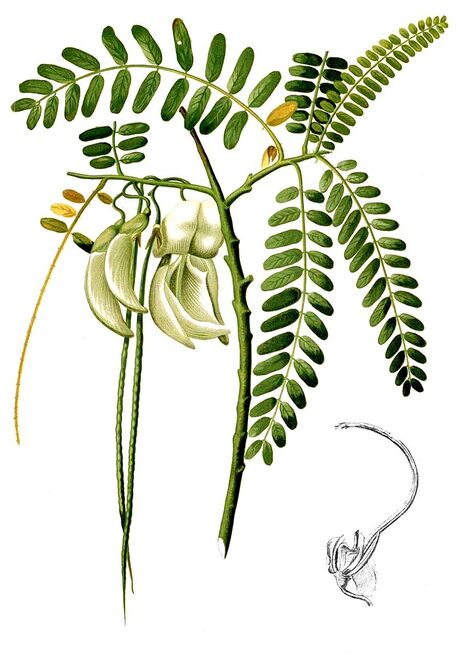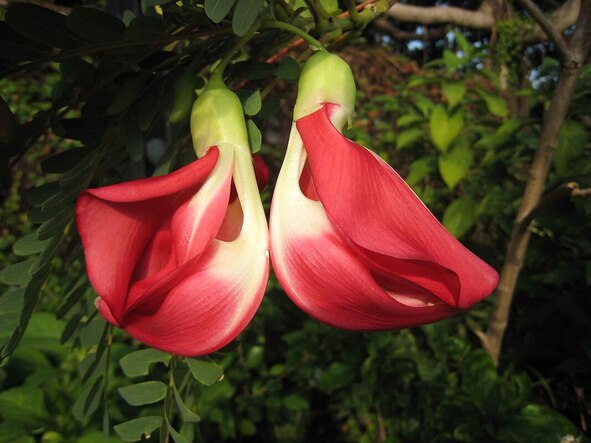Sentry Page Protection
Sesbania grandiflora
Red Wisteria, Swamp Pea
Po so cha པོ་སོ་ཆ (Fruits, Tibetan)
Agasti, Agatya, Muni, Munidrum (Ayurveda)
Agatti (Siddha)
Po so cha པོ་སོ་ཆ (Fruits, Tibetan)
Agasti, Agatya, Muni, Munidrum (Ayurveda)
Agatti (Siddha)
Sesbania grandiflora
Blanco, Flora de Filipinas. (1875)
Blanco, Flora de Filipinas. (1875)
Botanical name:
Sesbania grandiflora (syn. Agati grandiflora)
Parts used:
Whole Plant; bark; fruit; flowers
Temperature & Taste:
Cool, dry. Bitter
Sesbania grandiflora (syn. Agati grandiflora)
Parts used:
Whole Plant; bark; fruit; flowers
Temperature & Taste:
Cool, dry. Bitter
Uses:
1. Clears Heat, Resists Poison:
-Fever, Intermittent Fever (whole plant, fresh leaf)
-bark infusion for early stages of Eruptive Fevers (including Small Pox)
-Diarrhea, Dysentery (bark)
2. Clears Phlegm-Heat, Stops Cough:
-Catarrh
-Cough, Bronchitis from heat (leaf juice with honey)
-Glandular swelling, tumors (pods)
-flowers, whole plant, or root juice with Honey have been used for cough
3. Clears Liver Heat, Benefits Eyesight:
-Liver heat with Headache, sore eyes
-flowers prepared with ghee for night-blindness
4. Clears Wind-Heat, Stops Spasms:
-Headache
-Anxiety
-Convulsions, Epilepsy (leaf)
-Hypertension (plant, Philippines)
5. Emetic:
-large doses of the bark promote emesis
-in Tibet the fruit is said to be the best emetic
6. Benefits Semen:
-the flowers are used for 'Faults of the Semen' in Ayurveda
7. Externally:
-decoction of the bark is used to treat cuts and wounds
-root paste applied to swellings, scabies, skin eruptions and rheumatism
-leaf poultice applied to bruises
-leaf is chewed to clear heat and swelling of the mouth
-Leprosy
-Stomatitis
SEEDS:
Promotes Menstruation
BARK:
Indigestion, debility
Dose:
Juice of the whole plant: 10–20 mls.
Standard decoction of the whole plant: 50–100 mls.
Substitute:
1. The gum is used as a substitute for Gum Arabic. Conversely, Gum Arabic may be used in its place.
Juice of the whole plant: 10–20 mls.
Standard decoction of the whole plant: 50–100 mls.
Substitute:
1. The gum is used as a substitute for Gum Arabic. Conversely, Gum Arabic may be used in its place.
Main Combinations:
1. Tetanus, Sesbania, Vitex trifolia juice, Ginger, Eclipta alba juice, Leucas zeylanica, boiled in Coconut milk, adding Rice and Treacle to form a porridge.
2. Painful swellings, Sesbania root with Datura root are applied (Ayurveda)
Major Formulas:
Cautions:
1. Avoid overdose. Water extract of the flowers produced hemolysis of human erythrocytes even at low doses.
Main Preparations used:
1. Avoid overdose. Water extract of the flowers produced hemolysis of human erythrocytes even at low doses.
Main Preparations used:
Click the Tabs above for more information on this Medicine
|
'A native of the Eastern Islands, but cultivated in gardens all over India, and now quite naturalised. In Sanskrit it is called Agasti, Vrandri, Vaka and Sthula-pushpa, or "large-flowered." Its named Agasti after a rishi or sage of that name, the author of several Vedic hymns, who is said to have been the son of both Mitra and Varuna by Urvasi, and to have conquered and civilised Southern India. He also wrote on medicine, and his healing spiritis said still to haunt the mountains of Courtallum. To the present day his works are held in the highest estimation in the South of India. The flowers are sacred to Shiva and are supposed to represent the male and female generative organs.
The bark is very astringent, but not bitter, as stated in the Pharmacofceia of India, where it is recommended as a tonic by Dr. Bonavia. The statement that it is a bitter tonic occurs also in the Bengal Dispensatory. In Bombay the leaves or flowers are made use of by the |
natives, their juice being a popular remedy in nasal catarrh and headache; it is blown up the nostrils and causes a very copious discharge of fluid, relieving the pain and sense of weight in the frontal sinuses. The root of the red flowered variety, rubbed into a paste with water, is applied in rheumatism; from 1 to 2 tolas of the root-juice are given with honey as an expectorant in catarrh; a paste made of the root with an equal quantity of Stramonium root is applied to painful swellings. The flowers are cooked and eaten as a vegetable. The leaves are said to be aperient. Rumphius states that a poultice of the leaves is so popular a remedy in Amboyna for bruises, that the tree has become notorious as the "solatium et auxilium illorum qui vapulantur," and people who plant it near their houses are laughed at on this account. It is a curious coincidence that the Sanskrit name Vrandri signifies "enemy of sores" (Vrana-ari).' (Pharmacographia Indica, Dymock, 1890)
|


